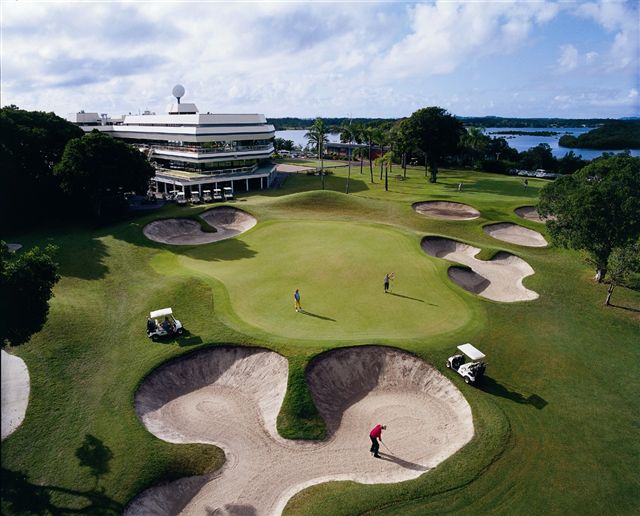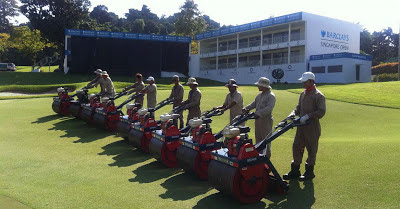The Board has agreed in principle that the grass type on the West greens requires changing and I trust the following information goes some way to answering Member’s questions. This may seem an unusual time to be discussing such a proposal with the West greens in perfect playing condition at the moment but this issue was raised in March this year at the end of an extremely wet and difficult summer for the greens. At the outset may I say that the bentgrass greens at CTHGC have always been difficult to maintain throughout the summer months, and particularly January and February due to the sub tropical climate we experience. A check of Greens / Course Committee minutes and reports over the years dating back to 1980, document that the greens grass type has been discussed on nearly an annual basis. So it is not a recent problem and is one that has probably been discussed by every Board of Directors since the bentgrass greens were planted. Indeed in 1980 a recommendation was put to the Board to convert all greens to couchgrass.


So for at least thirty two years there has been debate on the most suitable greens grass at CTHGC and throughout that time there have been many issues with greens that often led to temporary greens being in play and players suffering the consequences. Thankfully in my thirteen years I have only had one major problem requiring a temporary green with the bentgrass greens and that is with my nemesis, 17 West. There are many reasons to consider for changing grasses but in my opinion there are now the following most pressing arguments;
Ø Our climate. The summers experienced at CTHGC are too severe to make bentgrass a viable option without huge labour and plant protectant product usage. It is fact that bentgrass roots start stressing and dying off in soil temperatures above 24ºC. In the months of November through March our soil temperatures rarely fall below 23ºC and the irrigation water that is applied is normally a minimum of 26ºC. I have in fact recorded soil temperatures above 35ºC on many occasions and the water has been 30ºC on many occasions. The combination of these factors are a recipe for disaster.
Ø The age of the greens. Some of the existing West greens are more than 30 years old, albeit with constant patching and re-sowing prior to my arrival. Several of the greens, eg. 2, 3, 4, 10, 13 &15 have passed their use by date and are causing problems year round.
Ø Foreign grass invasion. Particularly couchgrass which has been controlled as far as possible with the available products. All I am able to do now is reduce the spread of the couchgrass. Greens 4, 6, 8, 10, 12, 14, 15 and 18 are the worst for contamination. This problem is most noticeable during the summer months when the bent is at its weakest and the invading couch at its strongest. The most difficult aspect of controlling the existing couchgrass is that to totally remove it from the surface it has to be sprayed out and then have at least 300mm of the growing medium removed and replaced. In the past fumigation could be used which provided a fast result and meant the surface could be re-seeded as was done on many occasions previously. Fumigation is now no longer available.
Ø Staffing. The maintenance of bentgrass greens in this climate, particularly through the period of October thru April, requires a huge commitment from the Superintendent to continually monitor the greens. One of the aspects that amazed me when I arrived here is just how much the greens can dry out overnight in comparison to greens in the southern States. Similarly the change in the greens from 2.30pm in the afternoon when the staff leave and 6.30pm when the sun stops beating down is substantial. This means the greens need to be monitored continually throughout the day, seven days a week and decisions on irrigation requirements assessed on a daily basis. This didn’t happen prior to my arrival with obvious results. Having bentgrass greens in this climate is like having a 2 week old baby that is in need of constant attention. Such constant attention requires a time commitment from the staff and the generation of workers coming through is not interested in working such hours and that trend seems to be worsening. The days of people working 70 plus hours a week as I do are numbered.
So what is the solution? In my mind the time has come for the greens grass on the West Course to be changed. Following is a discussion on possibilities.
In 2007 the Club undertook trials of six new improved “ultradwarf” varieties of couchgrass with a view to their suitability as a putting green grass at CTHGC. All of the varieties, proved to have a much finer leaf than “328” couchgrass (which we have on the River greens) and therefore provided a better putting surface. In the USA golf clubs in similar climatic conditions as we are across the States of Texas, Georgia, the Carolinas and Florida for example, are changing their greens from bentgrass to these new varieties at a startling rate. Unfortunately the grasses are still not commercially available in Australia so can’t be considered.
However, the couchgrass variety TifEagle was part of that trial and is available in Australia. Northlakes, Dent Island and Sanctuary Cove Palms are three courses who have used the variety over their entire course. Brisbane GC and the new course at Horton Park GC on the Sunshine Coast will be installing TifEagle in their greens in the next few years as will Arundel CC on the Gold Coast.
TifEagle is a much finer bladed couchgrass which translates to a smoother, faster putting surface. To achieve this it does have high input requirements such as frequent sanding and grooming. At most of the courses that have trialed or installed TifEagle in Australia there have been problems with disease in its early life. In the trials at CTHGC however, it was the grass with the least disease at establishment. (see photo) I have trialed it in a nursery green and the rate that it thatches up means it will require the constant work previously mentioned. It provides an excellent putting surface as the greens at Sanctuary Cove Palms and Northlakes demonstrate. It is also used extensively in the USA, particularly in Florida where the climate is similar to ours, with great results.
 |
| Disease infestation comparisons in 2007 trials |
Tifdwarf is another variety but has lost favour in Australia as most commercially available sources are not true to type and there are also ongoing disease issues with it.
Tifgreen or 328 is virtually the only other option and is in use on the River course at present. Its advantage is that we know it will grow here and survive the huge player numbers we experience but is an inferior surface to TifEagle. The Board is keen to still have two distinct grasses on the courses which is an idea with which I fully concur.
The following is the procedure that is recommended;
Ø Greens to have herbicide applied to eradicate foreign couchgrass. Two applications would be required. Greens would remain in play during this phase and temporary greens would be prepared at this time.
Ø 300mm of the growing profile to be removed out to the existing greens collar and further in some cases and down to the existing drainage. This would increase the putting surface area by a minimum of 120m² and the excavated material would then be spread in roughs to cover tree root areas to help solve another on course issue.
Ø Irrigation to be replaced.
Ø Growing medium to be replaced and contoured back to existing levels with minor alterations to allow for pin placement and water movement off the green.
Ø Some contouring works would be required on green surrounds to ensure drainage / water movement off the putting surface.
Ø Greens to be planted with stolons. Surrounds to be turfed.
The process as described above is not a full re-construction but rather a greens rejuvenation. Any greenside bunkers that require works such as drainage could be attended to at the same time. The greens would be stolonised rather than solid turfed as turfing immediately introduces a thatch layer which is the main problem you want to prevent against. There is also not enough turf available for purchase in SE Qld to solid turf.
The proposed timing of such a project is a start date of 2013 and the schedule of works would be;
Ø September 2 – Herbicide application and temporary green preparation.
Ø October 14 – Start excavation. Two greens could be excavated and replaced each week and grass planted the following Tuesday.
Ø All greens to be planted by November 19.
Ø A 12 week grow in time would see the first greens back in play January 14 and all greens in play February 11. This would allow for an adequate level of maturity for the turf going in to winter.
Ø A contingency plan would be needed to allow for weather interruption, both financially and time.
Ø Vehicle access tracks would be repaired after the last green is planted.
Ø 10 greens to be planted in 2013, including the practice green and 9 greens at the same time in 2014.
An information meeting for all members will be held in the Clubhouse on Wednesday August 22nd immediately following presentations at approximately 6.00pm. In the meantime if you would like a question answered please put it in the "comments" section and I will respond.



























